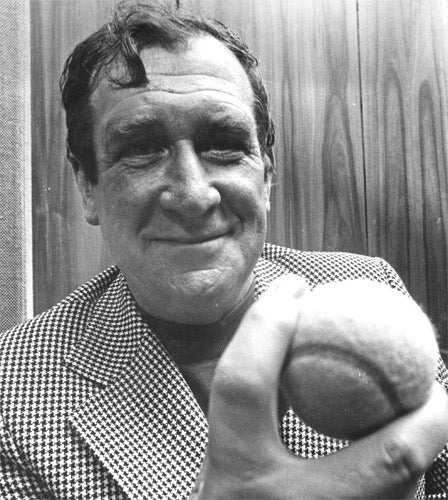Brian Viner: Laconic Laker left me light on O levels but forever in awe of his Old Trafford heroics
The Last Word

Jim Laker died 25 years ago today. For my generation, who came of age as cricket enthusiasts in the 1970s, he represents the golden age of BBC television's Test match coverage.
His gruff, slightly nasal: "Thank you, Richie, morning everyone", on taking the microphone from his great commentary-box compadre Richie Benaud was part of the soundtrack of my youth, no less than The Specials singing "Too Much Too Young".
Maybe we did have too much too young, all those hours of Test match coverage filling one of only three available TV channels. My older son is now the age I was in 1978, and seems to be revising much harder for his GCSEs than I did for my O levels. I was tempted from my text books 33 years ago by the twin seductresses of a football World Cup in Argentina, and England thumping Pakistan in one-day and Test cricket, distractions that did much the same damage to my exam results as Bob Willis and Chris Old, as laconically described by Laker, or Benaud, routinely did that summer to the Pakistani top order.
To those who had been schoolboys in the 1950s, however, the commentary-box version of Laker was merely a passing incarnation of the off-spinning hero of Old Trafford, the Yorkshireman who had saved his greatest deeds for an audience of Lancastrians. In 1978 my cricket-loving friends and I knew about Laker's 19 for 90, in the fourth Ashes Test in 1956, in much the same way that my son and his friends know about Ian Botham's heroics in 1981, interesting enough but only as a history lesson.
At least their history lesson comes in full Technicolor. For those of us who in 1956 weren't even padded up for the innings of life, jerky black-and-white newsreel footage is all we've seen of Laker's match, although it is enough to appreciate the singularly undemonstrative way, even in those undemonstrative times, in which he greeted each wicket to fall. It is said that when Laker got home that night, his wife Lilly, who was Austrian and had bewilderedly fielded lots of congratulatory phone calls, said, "Darling, did you do something good today?" There's no account of his response, but it was doubtless a shrug, and a gruff "not bad".
Laker was only 64 when he died. He could have been with us still, watching orgiastic eruptions on the taking of a wicket, the scoring of a goal, and shaking his big Yorkshire head in disbelief. Yet it would be wrong to assume from the old newsreel footage that there was no ferment on the field at Old Trafford. As Colin Cowdrey later told it, it was not an Australian who felt most humiliated by Laker's 19 wickets but his chippy Surrey and England team-mate Tony Lock, the left-arm spinner best-known these days as the answer to a quiz question: who took the only Aussie wicket that Jim Laker didn't in the 1956 Old Trafford Test?
The England captain that day, Peter May, knew how Lock was feeling. "Forget the scorebook, Tony, you played your part, too," he said afterwards. But Lock never did forget the scorebook, and nor, for happier reasons, and whether or not we were alive at the time, will the rest of us.
Why have sweet strikes become such a rare treat?
Reflecting on Tom Huddlestone's splendid goal in Tuesday's spectacular north London derby, Teddy Sheringham in the Sky Sports studio asserted that not many modern players know how to strike a ball from outside the box quite like the Tottenham midfielder.
He was right, and it's a subject I've been pondering for a while now. Top modern footballers can do all sorts of things that their counterparts even 20 years ago couldn't; for example, I am never less than incredulous at the seemingly effortless way so many of them can trap and control a pass that has come at them as if fired from a bazooka. But what has happened to the art of long-range shooting? With a lighter, more aerodynamic football it ought to be easier than it was when Bobby Charlton and Peter Lorimer showed the true meaning of leathering the ball, yet scarcely a game goes by without half a dozen hugely well-remunerated players either ballooning shots into row Z, or shanking them towards the corner flag.
I'm not talking about free-kicks, but about shots in open play. There is scant evidence that they are practised on Premier League training grounds, with most teams content to rely on the one player, if that, who can regularly hit the target from 30 yards plus. For Everton, who visit Manchester United this lunchtime, it is Diniyar Bilyaletdinov. He hasn't done a whole lot else this season, but he can't half propel a football in the right direction. It's dispiriting that he's one of so few.
Pole's position is back at front of grid
The Polish Formula One driver Robert Kubica is expected to leave hospital soon, following his horrific rally crash. I interviewed him three years ago, and he told me how much interest his success had kindled in his homeland, where it was previously so little-known that folk called it Formula First. Now, grands prix get viewing figures upwards of four million, more than 10 per cent of Poland's population. But only when Kubica's competing. Let us hope he does so again.

Join our commenting forum
Join thought-provoking conversations, follow other Independent readers and see their replies